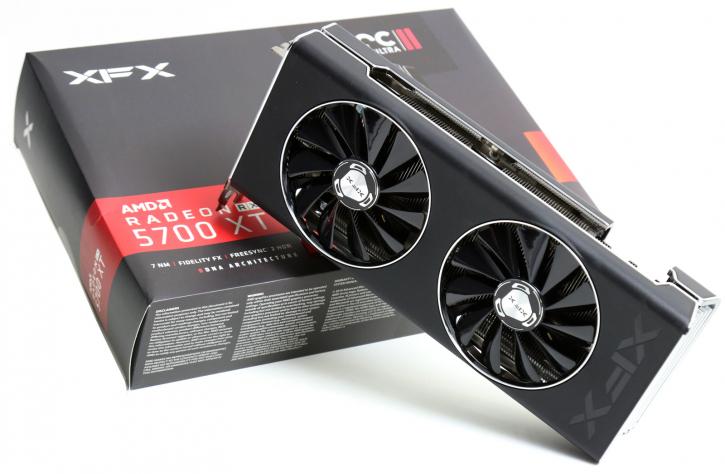Final words and conclusion
.final words
After all this time it is really nice to have been able to review an XFX product again. The new THICC II Ultra performs well and looks fantastic. You'll notice that XFX outs a THICC II model at 419,- USD and today's tested THICC II Ultra at 439,- USD. The sole difference is the high power allowance of 210 Watt TGP which will get you an additional frame or two overall. So what's suited best for you only you can decide of course, personally the non-ULtra card so close to the reference MSRP is obviously the more appealing model value for money wise.
As stated in the reference reviews already, NAVI sits at the Vega performance level. So the improved architecture is sound, and works. Compared to reference, depending on how and where you measure you gain an extra 2% in performance, that can be a bit higher depending on title and resolution thgouh. The realm AMD is sitting in performance-wise with the RX 5700 series is the non-Super models 2060 and 2070 with exceptions here and there. Then there is, of course, the discussion on how relevant you find hardware-accelerated Raytracing and Tensor support. Most of you don't care at this time, but much like anything in the tech industry, everything will evolve, and AMD positioned itself to be smacked down in the middle of that next step in the gaming evolution. By not offering at least RT support, their trump card really needs to be pricing and proper shader-based gaming performance.
.performance
Both Radeon RX 5700 cards show good, in fact, super strength at Quad HD resolutions in that 2560x1440 realm of resolutions. Games like Battlefield V will make you aim, shoot and smile. As always comparing apples and oranges, the performance results vary here and there as each architecture offers advantages and disadvantaged in certain game render workloads. Battlefield V and Metro: Exodus skyrockets for NAVI. So you'll be seeing wins and losses in perf compared to team green. AMD has got the right amount of graphics memory applied, the right type this time as well as 8GB GDDR6 graphics memory running over that 256-bit bus at 14 Gbps, is done right. The new architecture does show strength and IPC increase, especially seen from Polaris the results are pretty amazing. However, that statement has no merit, as they are not priced in the same region. Realistically the XT card makes good sense in the Wide Quad HD space (monitor resolution of 2560x1440) and can even properly handle games at 3840x2160 (Ultra HD). Result vary per game title though.
.pricing
The XT overall as a reference product remains steeply-priced at 399 USD. The XFX AIB custom premium boards are roughly 25 bucks more expensive, and XFX advertises this product with a 439 USD tag. Again, that's the Ultra model, the non Ultra model is the same just a fraction slower, and that one is likely the more attractive product at 419 USD.
.cooling & noise levels
The THICC II Ultra is an impressive graphics card, however, as you have noticed, the acoustics are reasonable. you can opt a silent BIOS which you can download at XFX, bringing down the DBa value towards a good 39 DBa at the cost of maybe 2% performance. The performance BIOS is a tad louder but can be rated as a moderate to okay accoustic level.
.energy
The TDP for this XT we measure to be roughly 269 Watts. That number varies a bit per game title, workload, resolution and even refresh rate of course. It's a substantial wattage, especially compared to the competition's products in the same performance bracket. XFX has increased the power allowance a bit, in order to gain more perf
.conclusion
When the new THICC II Ultra arrived, I literally had a smile on my face as (and this is subjective) this non-RGB lit product just looks fantastic. Not just that, the performance you'll get from this Radeon 5700 XT card is significant as well. Arguably you need to decide whether or not to spend the 20 bucks extra for the Ultra model as honestly the 419 USD price mark for the non-ultra version we feel is the more appealing choice. We have to talk acoustics, you've seen the numbers for both perf and silent modes, it's not very sexy. I find the silent mode to be borderline acceptable at best. At this time I need to give XFX a bit of time to look into this, as I do expect another firmware update on the final retail products as this noise level is just not okay. There is margin to play with for XFX, we'll need to keep you updated on this one though. These cards behave extremely well in the normalized 2560x1440 range of resolutions, but with some titles, perf can cave in where at others it takes a lead. Whether or not this performance is justified at the recommended retail prices, I don't know and we'll have to wait and see how that pans out. GDDR6 then, the card comes with a proper 8GB of GDDR6 memory. Really, that exactly right and what these products it needs. With 8GB a lack of graphics memory, however, is not something you'll easily run into for the coming years. A game like Battlefield V manages to pull roughly 110+ FPS on average in WQHD for the XT. That's 80 FPS for Shadow of the Tomb Raider and 100+ FPS in Far Cry: New Dawn. These are good values at such monitor resolutions and remember we always apply the better if not best, relevant image quality settings. The non-XT model overall is 10% slower. With cooling, noise levels and looks addressed the rest all boils down to performance and sheer pricing. The XT does perform well in many games, and a bit less in others. As such pricing will be so important as NVIDIA has some very competitive Super cards available as well. And whether you like or disklike RT and DLSS, it does offer it as extra. From a hardware point of view and aesthetics, the card ticks most if not all of the right boxes. Acoustics are a little so-so though.
** This article has been updated on September 11th - as it seems the BIOS updates we received did not kick in properly. After multiple clean driver installations and power-downs the final fan ramp up values came alive, making this product perform a lot better on its acoustics front.
- Unigine Heaven Stress test
- MSI AfterBurner
- 3DMark FireStrike + Time Spy + Port Royale)
- Download AMD Radeon drivers
- Download NVIDIA GeForce drivers
Sign up to receive a notification when we publish a new article.
Or go back to Guru3D's front page



